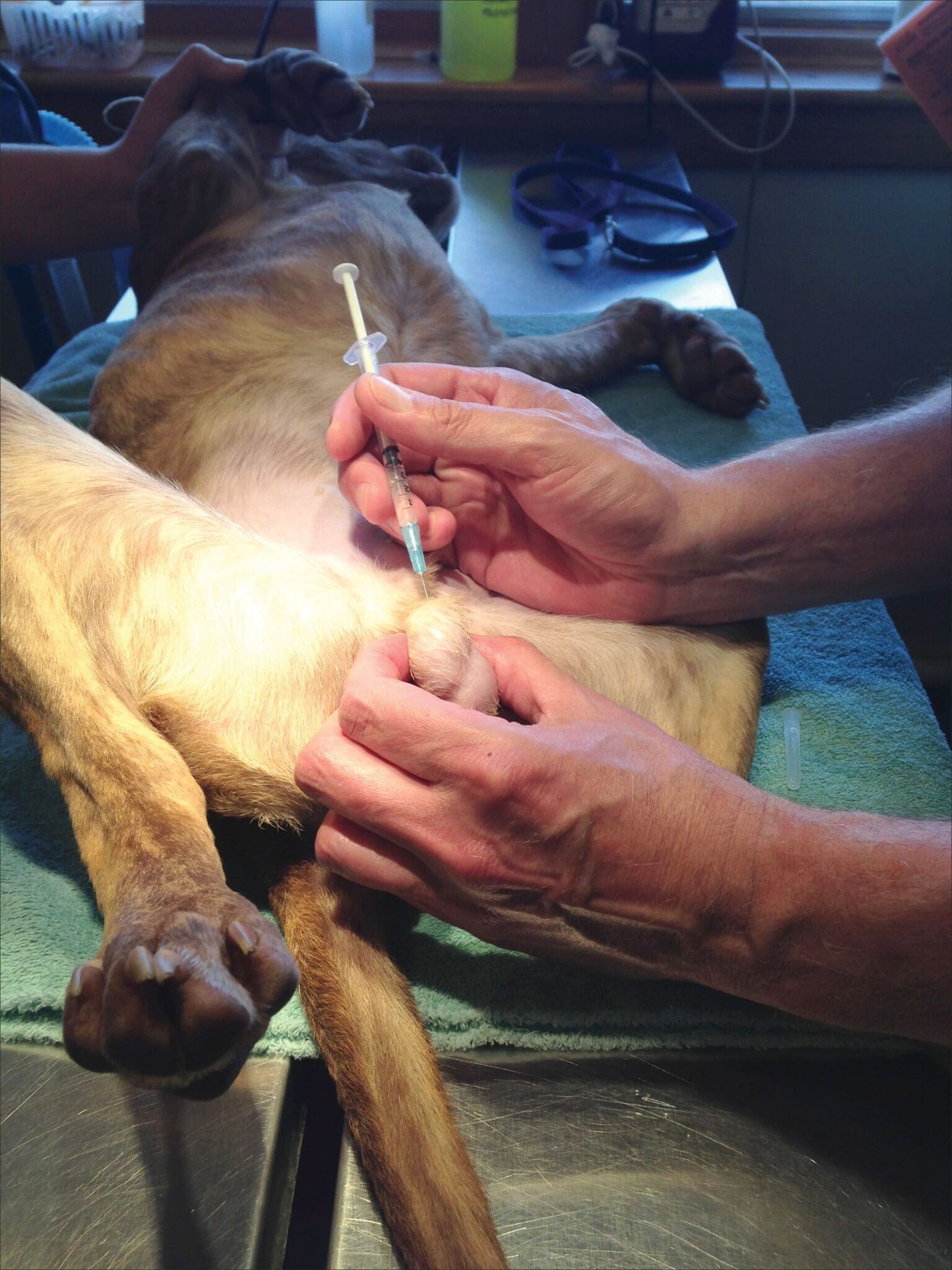Sounds odd to say, but I’m accustomed to standing over a fully anesthetized dog holding his testicles in one hand. Until recently, if I did, in fact, have his testicles in one hand, I’d usually have a scalpel in the other, preparing to neuter him. But on a day not long ago, I found myself armed with only a needle and syringe in my other hand, preparing to neuter a dog who was merely sedated.

We’d all love to see a procedure that can easily and permanently sterilize a male dog without side effects or complications. Historically, surgery has been the most commonly used option in the U.S. Contained in the syringe I held was an exciting new product, Zeuterin, which permanently sterilizes male dogs (between the ages of three and 10 months) without surgery. Will “zeutering” prove to be a better option? I was attending a training session to learn more.
Zeuterin is comprised of zinc gluconate and arginine, and is injected with a needle into the center of each of a young dog’s testicles. The compound diffuses in all directions in the testes, causing permanent and irreversible fibrosis in the testicle, rendering the dog incapable of producing any new sperm. Once the sperm currently in the testicles have been cleared (over the course of several weeks), the dog is sterile.
The needle used for the procedure is a very small one, and the procedure is remarkably painless. The dog does not have to be anesthetized. In theory, a calm dog being “zeutered” by an experienced veterinarian could even receive the injection without sedation. In practice, though, sedation is a very good idea: if the dog moves during the procedure there could be side effects, and dogs who have been subjected to the treatment should receive a small “Z” tattoo on the groin area to identify them as zeutered – and tattoos definitely require sedation.
After the injection, the dog’s testicles may briefly swell. Usually, they then atrophy, so that eventually they will be smaller that before, or sometimes, not even easily visible.
For dogs whose testicles do remain visible, though, there can be some confusion about whether they’re intact or not. This is the point of the “Z” tattoo, of course – and the company that manufactures the compound also sells “I’m Zeutered!” T-shirts for owners who want to prevent glares from the canine-testicle-averse passers-by at the dog park.
“Zeuter” vs. Neuter
The zeutering procedure has some obvious benefits. General anesthesia always carries a small risk, so avoiding it is unquestionably a good thing. And if you can avoid removing a dog’s organs, why wouldn’t you?
But, as with every medical procedure, there can be side effects to Zeuterin. Some dogs can be in pain afterward, for several days up to a week, and some dogs may vomit.
Occasionally, if the compound isn’t injected just so – if some of it erroneously comes into contact with the scrotal skin (rather than being injected properly into the center of the testes), the skin of the testicles can become irritated and ulcerate. In bad cases, a dog may have to go under the knife after all, to have his entire scrotum removed in a more invasive procedure than a simple castration would have been.
Of course, surgery poses the risk of complications as well, such as infections of the surgical site, or swelling of the empty scrotum with fluid (known as a seroma).
There is another significant difference between surgical neutering and zeutering, though, and it has to do with testosterone. The procedure you choose for your next male puppy may well be determined by how you feel about that hormone!

The Pros and Cons of Testosterone in Dogs
One of the most interesting things about this product is that it reduces testosterone levels in dogs who have had the procedure by only about 50 percent. Traditional surgical castration reduces the dog’s testosterone level to almost zero. Is this a good thing or a bad thing?
Testosterone is associated with some really obnoxious canine behaviors: mounting, marking, roaming, and some types of aggression. Veterinarians have traditionally recommended castration for dogs whose owners who want to reduce these behaviors.
The jury is still out on whether a 50 percent testosterone reduction will reduce those behaviors as well as castration does – but then, the jury still hasn’t ruled on how effective surgical castration (and its attendant near-total testosterone reduction) is for helping to eliminate the “problem” behaviors in male dogs, either. That said, if you’re thinking about sterilizing an animal specifically because of problem behaviors, I’d take the safest route and go with 100 percent testosterone reduction (surgery).
Be aware that there is a growing number of veterinarians and dog owners who believe that the health benefits of testosterone outweigh its potential for negative effects on the dog’s behavior. It’s a hot debate; some studies have found a correlation between neutering and the development later in life of certain kinds of cancer (specifically osteosarcoma, hemangiosarcoma, and prostate cancer), as well as an increased risk of tearing the cranial cruciate ligament (CCL). Note that while a CCL tear is not life-threatening, it is certainly expensive to fix.
On the other hand, neutering has also been correlated with a longer life, despite the risk of cancer, and a reduced chance of death by infection.
Warning: the studies regarding the pros and cons of neutering are very difficult to interpret! And many of the effects that are seen may be the result of different levels of healthcare provided by different owners. As just one example, it’s possible that dogs who are not neutered are just as likely to develop cancer, but less likely to be diagnosed with cancer. This could happen if owners who can’t afford to neuter their dogs are also unable to afford veterinary care as their dogs age.
There may be other reasons that neutering correlates with an increased risk of cancer and CCL tears; and, of course, improved management and access to veterinary care is almost certainly why neutering correlates with longer life expectancies. (By the way, I’m not implying that responsible breeders fail to provide their dogs with good veterinary care, only that responsible breeders are a minority among those who don’t neuter their dogs.) Testosterone is a powerful hormone; it’s possible that a lifetime of exposure to it has beneficial and detrimental effects on dogs. Amazingly, we still don’t know enough about it. And because zeutering is so new, we know even less about its long-term health effects than we do about surgical neutering.
Choosing For Your Dog
So in the end, should you neuter your dog, zeuter him, or leave him intact and manage him carefully? There are a lot of factors to consider, and the right decision will vary from situation to situation.
If behavioral changes are your biggest concern, your best bet is always to choose an animal who is well suited to your lifestyle and to invest time into a good training program. However, neutering may help, as may zeutering.
More and more owners say that the health benefits offered by testosterone are their priority, and so they are leaving their male dogs intact. They should be aware that the intended benefits remain the topic of much discussion and study and few conclusions.
If your veterinarian offers zeutering, ask about her experience with the product and the procedure; personally, I would have a dog zeutered only by someone who is familiar with the procedure. When the product has been on the market for a decade or two, experience will tell us a lot – and who knows, there may be other options by then.
The History of Zeuterin
The drug now called Zeuterin(TM) was briefly on the market a decade ago. Then called Neutersol, the drug was sold to veterinarians with little training or support. Many dogs suffered adverse reactions (such as inflamed testicles, which then required a far more invasive surgery than a conventional castration). The resulting poor reputation of the drug led to the 2005 death of the company then making and marketing the product, about two years after the product’s introduction.
Ark Sciences, of Irvington, New York, was founded in 2007 by Joe Tosini, an original investor in Neutersol. Tosini believes strongly in the product’s promise, but says that it was rolled out incorrectly. Under Tosini, Ark Sciences bought the rights to Neutersol, and built a team of advisors to help him resubmit the product for FDA approval (which it achieved in August 2012) and to relaunch the product with a vastly improved strategy. Ark Sciences requires veterinarians who want to provide zeutering services to their clients to complete a five-hour course – encompassing a two-hour online course, and three hours of hands-on training (which includes injecting the drug into several dogs).
Ark Sciences has also limited its recommendations for the procedure to dogs between three and 10 months of age who have two fully descended testicles in the scrotum, healthy scrotal skin, and no testicular abnormalities, such as pre-existing fibrosis, tumors, or transmissible venereal tumors (TVT).
According to the company’s online FAQs: “While adverse reactions requiring medical treatment occurred in only 1.1% of the dogs, there were minor reactions observed in 6.3% of dogs during the FDA study. Local reactions included testicular swelling (normal reaction to the injection), pain (dogs may resist sitting or may sit with both hind legs open), biting and licking at the scrotum, swelling of the prepuce and irritation, dermatitis, ulceration, infection, dryness or bruising of the scrotum. Systemic reactions included an increase in the white blood cell count, vomiting, anorexia (loss of appetite), lethargy (tiredness or abnormal attitude), and diarrhea.
“Most reactions were seen within the first seven days after the injection. Over 93% of dogs did not show any signs of post procedure pain. When pain was detected, it was most commonly seen in the first two days. No pain management medications were used in the study. Vomiting was most commonly seen on the day of the injection (within one minute and four hours after the injection). It is recommended to withhold food for 12 hours prior to injection to help prevent vomiting, which occurred in 4% of dogs. Your dog’s testicles may remain slightly enlarged but non-painful for a few months after the injection. Proper injection technique and owner observation post-injection is critical to avoid any potential undesirable side effects.”
Other Nonsurgical Contraception Innovations for Dogs
Zeuterin is a major new product, but there are other products under development that may eventually offer additional options for non-surgical contraception. The two main approaches are chemical contraception, such as Zeuterin or hormonal birth control, and immunocontraception, which actually uses the body’s own immune system against part of the reproductive system.
For example, GonaCon is a vaccine that teaches the immune system to target GnRH, the “master hormone” of reproduction. This product has been tested in cats and deer, and usually lasts for several years. Unfortunately, early versions had unacceptable side effects in dogs. It doesn’t provide 100 percent reliable contraception, so while it’s useful for feral animals, it’s not yet ready for use in companion animals.
Another immunocontraceptive that has been used with some success in wild horses is a vaccine for females that works against the zona pellucida, the coating around the egg. This vaccine has been tested in cats with poor results. It hasn’t yet been used in dogs.
Some types of hormonal birth control, such as deslorelin, can be implanted into male or female dogs to provide long term but reversible contraception. Like GonaCon, deslorelin targets GnRH, at the top of the reproductive system. This product is marketed for ferrets and horses, and is not commonly used in dogs. Additionally, as with any hormonal birth control, it can have side effects.
Because surgical spays and neuters are so well accepted in the U.S., there is not a lot of pressure to find alternatives in dogs. Most research is targeted at populations that cannot easily be reached with surgery, such as feral cats and horses, and wild deer. There is some interest in finding non-surgical solutions for feral dogs in other countries, but very little funding for such research.
For more information, keep an eye on the Alliance for Contraception in Dogs & Cats. This non-profit organization helpfully provides detailed analyses of various products that are available and will keep you up to date about any news in this very interesting and underserved field.
Jessica Hekman, DVM, MS completed her shelter medicine internship at the University of Florida’s Maddie’s Shelter Medicine Program in 2013. She is now studying the genetics of dog behavior in Illinois, where she lives with her husband and three dogs. You can learn more about Dr. Hekman at her blog, dogzombie.blogspot.com, a blog about dog brains and behavior (and sometimes shelter medicine), or follow her on Twitter @dogzombieblog.







Hello, I recently adopted a 10 week old pup that was already neutered! I was shocked! Ive been working in the vet and training industry for 40 + yrs and never heard of this practice! Now I am concerned for a loved pets health. A question never found the answer to, Is There a replacement for growth hormones in a dog that is going to be good sized, over 60 lbs if Ive judged it right, herding breed and very possibly guarding like Anatolian Shepard! He is growing very lanky, at just 12 weeks he is over 20 lbs. i feed a raw diet, Purchased locally. I have an intact 16+yr old Border Terrier blind and deaf, but still not ready to pass. Ive alwas kept my boys intact and never had roaming or aggression issues, of course I trained them all, and enjoyed their healthy existence!
Did you ever get an answer for this? Which vet would neuter so young?